Related Research Articles

Veins are blood vessels in the circulatory system of humans and most other animals that carry blood toward the heart. Most veins carry deoxygenated blood from the tissues back to the heart; exceptions are those of the pulmonary and fetal circulations which carry oxygenated blood to the heart. In the systemic circulation arteries carry oxygenated blood away from the heart, and veins return deoxygenated blood to the heart, in the deep veins.

A central venous catheter (CVC), also known as a central line (c-line), central venous line, or central venous access catheter, is a catheter placed into a large vein. It is a form of venous access. Placement of larger catheters in more centrally located veins is often needed in critically ill patients, or in those requiring prolonged intravenous therapies, for more reliable vascular access. These catheters are commonly placed in veins in the neck, chest, groin, or through veins in the arms.

Intravenous therapy is a medical technique that administers fluids, medications and nutrients directly into a person's vein. The intravenous route of administration is commonly used for rehydration or to provide nutrients for those who cannot, or will not—due to reduced mental states or otherwise—consume food or water by mouth. It may also be used to administer medications or other medical therapy such as blood products or electrolytes to correct electrolyte imbalances. Attempts at providing intravenous therapy have been recorded as early as the 1400s, but the practice did not become widespread until the 1900s after the development of techniques for safe, effective use.
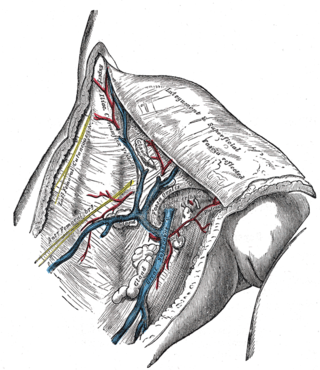
The great saphenous vein(GSV), or long saphenous vein; ) is a large, subcutaneous, superficial vein of the leg. It is the longest vein in the body, running along the length of the lower limb, returning blood from the foot, leg and thigh to the deep femoral vein at the femoral triangle.
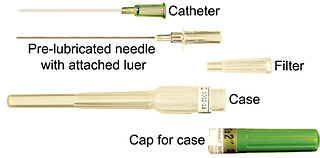
In medicine, a catheter (/ˈkæθətər/) is a thin tube made from medical grade materials serving a broad range of functions. Catheters are medical devices that can be inserted in the body to treat diseases or perform a surgical procedure. Catheters are manufactured for specific applications, such as cardiovascular, urological, gastrointestinal, neurovascular and ophthalmic procedures. The process of inserting a catheter is catheterization.

Interventional radiology (IR) is a medical specialty that performs various minimally-invasive procedures using medical imaging guidance, such as x-ray fluoroscopy, computed tomography, magnetic resonance imaging, or ultrasound. IR performs both diagnostic and therapeutic procedures through very small incisions or body orifices. Diagnostic IR procedures are those intended to help make a diagnosis or guide further medical treatment, and include image-guided biopsy of a tumor or injection of an imaging contrast agent into a hollow structure, such as a blood vessel or a duct. By contrast, therapeutic IR procedures provide direct treatment—they include catheter-based medicine delivery, medical device placement, and angioplasty of narrowed structures.
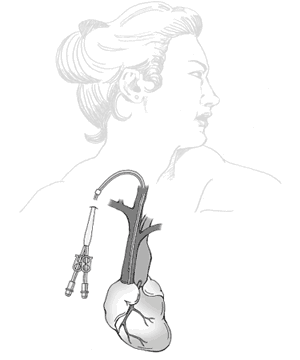
A dialysis catheter is a catheter used for exchanging blood to and from a hemodialysis machine and a patient.

A peripherally inserted central catheter, less commonly called a percutaneous indwelling central catheter, is a form of intravenous access that can be used for a prolonged period of time or for administration of substances that should not be done peripherally. It is a catheter that enters the body through the skin (percutaneously) at a peripheral site, extends to the superior vena cava, and stays in place for days, weeks or even months.
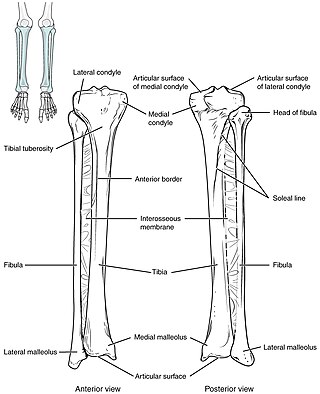
Intraosseous infusion (IO) is the process of injecting medications, fluids, or blood products directly into the marrow of a bone; this provides a non-collapsible entry point into the systemic venous system. The intraosseous infusion technique is used to provide fluids and medication when intravenous access is not available or not feasible. Intraosseous infusions allow for the administered medications and fluids to go directly into the vascular system. The IO route of fluid and medication administration is an alternative to the preferred intravascular route when the latter cannot be established in a timely manner in emergent situations. Intraosseous infusions are used when people have compromised intravenous access and need immediate delivery of life-saving fluids and medications.
Endovenous laser treatment (ELT) is a minimally invasive ultrasound-guided technique used for treating varicose veins using laser energy commonly performed by a phlebologist, interventional radiologist or vascular surgeon.
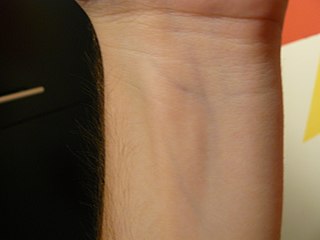
The peripheral vascular system is the part of the circulatory system that consists of the veins and arteries not in the chest or abdomen. The peripheral arteries supply oxygenated blood to the body, and the peripheral veins lead deoxygenated blood from the capillaries in the extremities back to the heart.

Vascular disease is a class of diseases of the vessels of the circulatory system in the body, including blood vessels – the arteries and veins, and the lymphatic vessels. Vascular disease is a subgroup of cardiovascular disease. Disorders in this vast network of blood and lymph vessels can cause a range of health problems that can sometimes become severe, and fatal. Coronary heart disease for example, is the leading cause of death for men and women in the United States.
Vascular access refers to a rapid, direct method of introducing or removing devices or chemicals from the bloodstream. In hemodialysis, vascular access is used to remove the patient's blood so that it can be filtered through the dialyzer. Three primary methods are used to gain access to the blood: an intravenous catheter, an arteriovenous fistula (AV) or a synthetic graft. In the latter two, needles are used to puncture the graft or fistula each time dialysis is performed.
Venous cutdown is an emergency procedure in which the vein is exposed surgically and then a cannula is inserted into the vein under direct vision. It is used for venous access in cases of trauma, and hypovolemic shock when the use of a peripheral venous catheter is either difficult or impossible. The great saphenous vein is most commonly used. This procedure has fallen out of favor with the development of safer techniques for central venous catheterization such as the Seldinger technique, the modified Seldinger technique, intraosseous infusion, as well as the use of ultrasound guidance for placement of central venous catheters without using the cutdown technique.

An umbilical line is a catheter that is inserted into one of the two arteries or the vein of the umbilical cord. Generally the UAC/UVC is used in Neonatal Intensive Care Units (NICU) as it provides quick access to the central circulation of premature infants. UAC/UVC lines can be placed at the time of birth and allow medical staff to quickly infuse fluids, inotropic drugs, and blood if required. It is sometimes used in term or near-term newborns in whom the umbilical cord stump is still connected to the circulatory system. Medications, fluids, and blood can be given through this catheter and it allows monitoring of blood gasses and withdrawing of blood samples. Transumbilical catheter intervention is also a method of gaining access to the heart, for example to surgically correct a patent ductus arteriosus.

In medicine, a port is a small medical appliance that is installed beneath the skin. A catheter connects the port to a vein. Under the skin, the port has a septum through which drugs can be injected and blood samples can be drawn many times, usually with less discomfort for the patient than a more typical "needle stick".
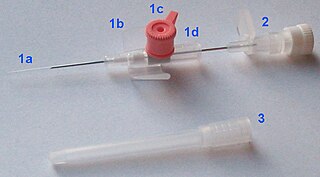
In medicine, a peripheral venous catheter, peripheral venous line, peripheral venous access catheter, or peripheral intravenous catheter, is a catheter placed into a peripheral vein for venous access to administer intravenous therapy such as medication fluids.
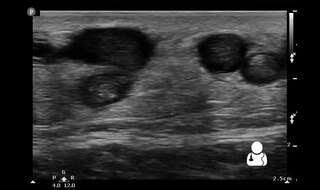
Superficial thrombophlebitis is a thrombosis and inflammation of superficial veins which presents as a painful induration with erythema, often in a linear or branching configuration forming cords.
In medicine, vascular access is a means of accessing the bloodstream through the peripheral or central blood vessels in order to obtain blood or deliver medications including chemotherapy. A vascular access procedure involves insertion of a sterile plastic tube called a catheter into a blood vessel. Types of catheters can be either peripherally or centrally located. Peripheral catheters are approximately one inch (25 mm) long and are inserted into the small veins of the forearm. Central catheters are bigger and longer and are inserted into the large veins of the extremities, neck, or chest. Central venous catheters are the primary modality used for delivery of chemotherapeutic agents. The duration of central venous catheterization is dependent on the type of treatment given.
Therapeutic apheresis is a treatment modality that processes whole blood through medical technologies for the purpose of separating it into components and removing identified pathological cellular or plasma components. Pediatric therapeutic apheresis treatments includes plasma exchange, red cell exchange/depletion, stem cell collections, leukodepletion and plasma exchange with secondary plasma device. There are considerations to be made when performing apheresis in pediatric patients, with the understanding that the apheresis technology and equipment used to perform adult apheresis are also used for pediatric apheresis. Additionally, pediatric patients require advance monitoring and clinical accommodations, due to their smaller body mass and immature body system functions, to safely perform treatments.
References
- 1 2 3 4 5 Cheung E, Baerlocher MO, Asch M, Myers A (May 2009). "Venous access: a practical review for 2009". Canadian Family Physician. 55 (5): 494–496. PMC 2682308 . PMID 19439704.
- 1 2 3 4 5 Naik VM, Mantha SS, Rayani BK (September 2019). "Vascular access in children". Indian Journal of Anaesthesia. 63 (9): 737–745. doi:10.4103/ija.IJA_489_19. PMC 6761776 . PMID 31571687.
- ↑ "Vascular Access Device (VAD) Selection and Procedures" (PDF).
{{cite web}}: CS1 maint: url-status (link) - ↑ Sou V, McManus C, Mifflin N, Frost SA, Ale J, Alexandrou E (2017). "A clinical pathway for the management of difficult venous access". BMC Nursing. 16: 64. doi:10.1186/s12912-017-0261-z. PMC 5693534 . PMID 29176933.
- ↑ McKean SC (2012). Principles and practice of hospital medicine. New York: McGraw-Hill. ISBN 9780071603898. OCLC 721902323.
- ↑ Ge X, Cavallazzi R, Li C, Pan SM, Wang YW, Wang FL (March 2012). "Central venous access sites for the prevention of venous thrombosis, stenosis and infection". The Cochrane Database of Systematic Reviews. 2018 (3): CD004084. doi:10.1002/14651858.CD004084.pub3. PMC 6516884 . PMID 22419292.
- ↑ Horattas MC, Trupiano J, Hopkins S, Pasini D, Martino C, Murty A (February 2001). "Changing concepts in long-term central venous access: catheter selection and cost savings". American Journal of Infection Control. 29 (1): 32–40. doi:10.1067/mic.2001.111536. PMID 11172316.
- ↑ Moir D, Bodenham A (August 2018). "A narrative review of long-term central venous access devices for the intensivist". Journal of the Intensive Care Society. 19 (3): 236–246. doi:10.1177/1751143717741249. PMC 6110032 . PMID 30159016.
- 1 2 Goossens GA (2015). "Flushing and Locking of Venous Catheters: Available Evidence and Evidence Deficit". Nursing Research and Practice. 2015: 985686. doi: 10.1155/2015/985686 . PMC 4446496 . PMID 26075094.
- ↑ Tobias JD, Ross AK (February 2010). "Intraosseous infusions: a review for the anesthesiologist with a focus on pediatric use". Anesthesia and Analgesia. 110 (2): 391–401. doi: 10.1213/ANE.0b013e3181c03c7f . PMID 19897801. S2CID 22669421.
- ↑ Lee MM, Loyd JW (2019). Saphenous Vein Cutdown. PMID 30422475 . Retrieved 2019-10-31.
{{cite book}}:|work=ignored (help) - ↑ Haas NA (December 2004). "Clinical review: vascular access for fluid infusion in children". Critical Care. 8 (6): 478–484. doi:10.1186/cc2880. PMC 1065040 . PMID 15566619.